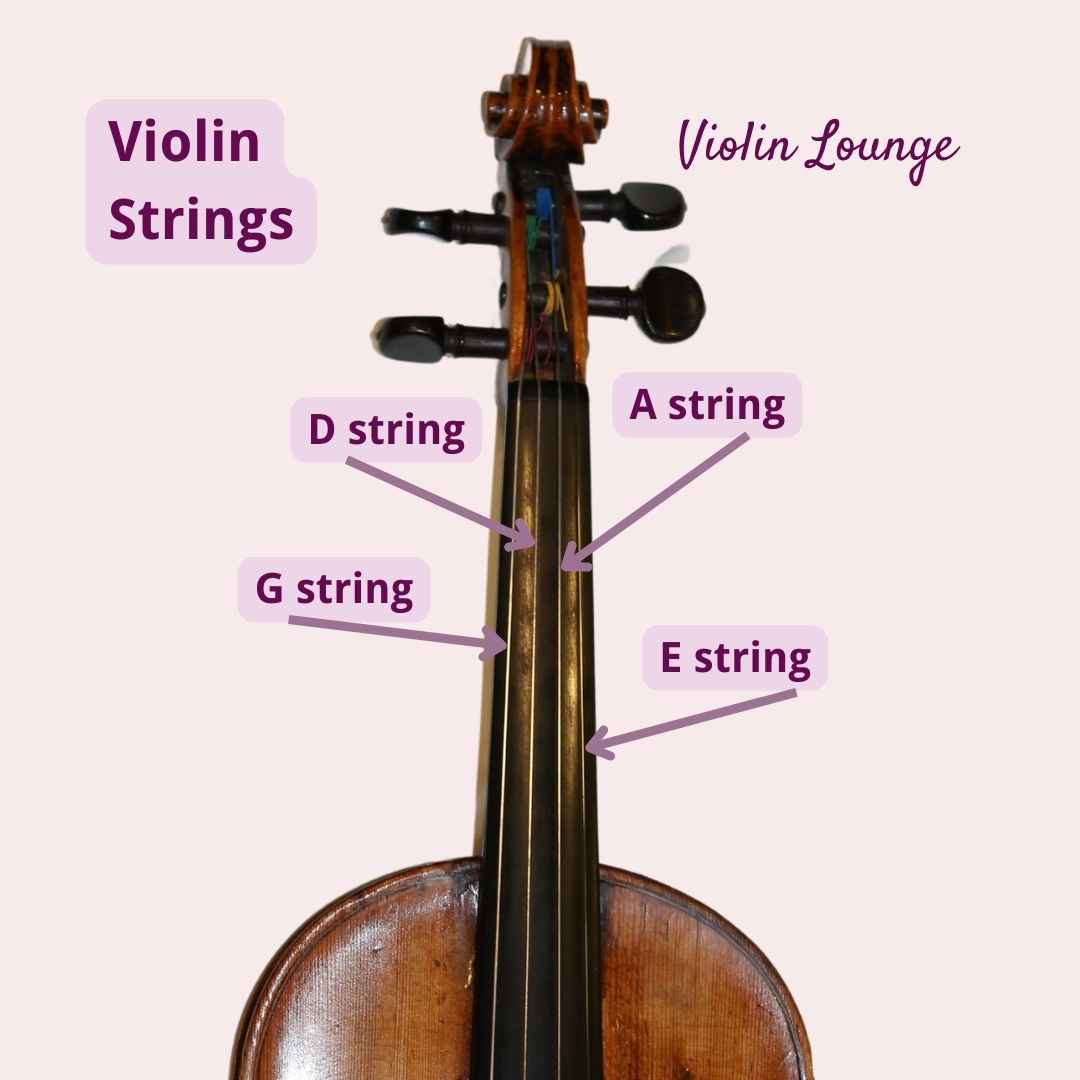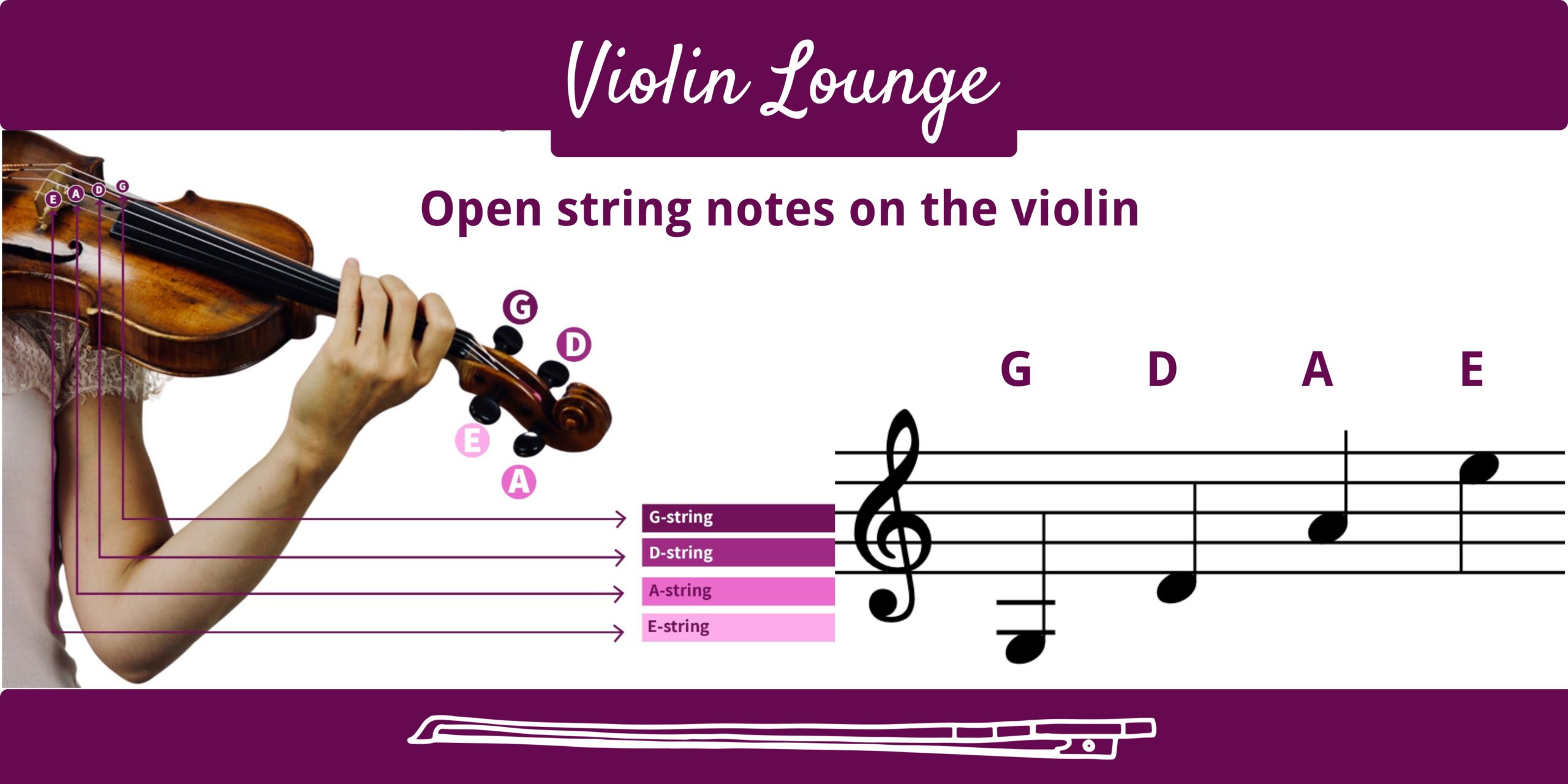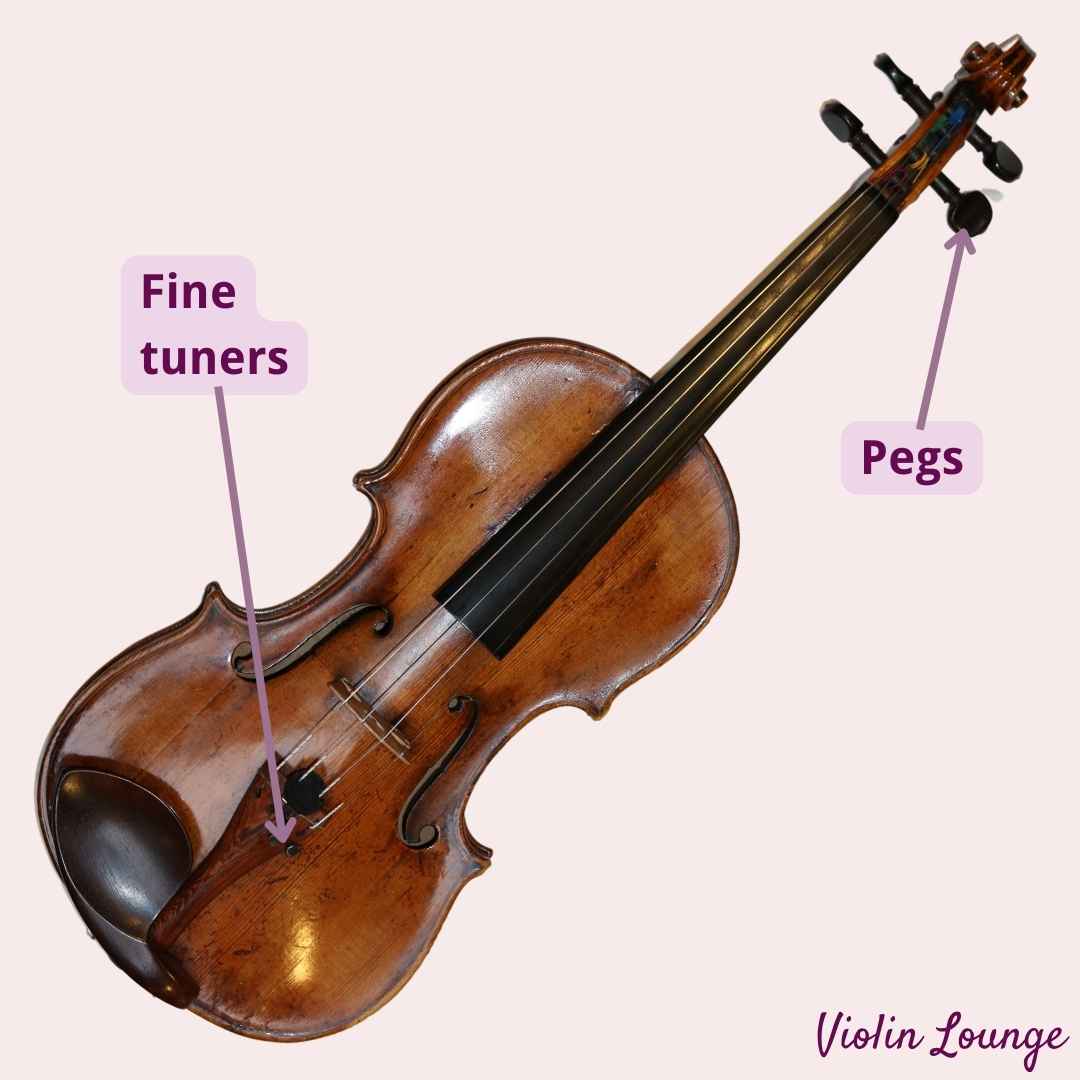Strings on the Violin Explained: easy guide for newbies!
Learn what the open strings on the violin are, how they are tuned, the note names and how they are notated in sheet music
This blog post answers all the questions you might have if you’re new to the violin. With the open string exercises and tips you can get started right away.
How many strings does the violin have?
The violin has four strings. From low to high the strings are G, D, A and E. There are some exceptions of five string violins with a lower C and even seven string electric violins, but they are not so common and often electric. The violins you see in a symphony orchestra have four strings.
What are the notes names of the open strings on the violin?
The violin is tuned in fifths and the pitches of the open violin strings are G3, D4, A4 and E5. The note names are G, D, A and E. Play the tuning notes below to listen to the sound of each of the open strings.

Listen to the sound of the open strings on the violin:
How are the open violin strings notated in sheet music?
See the image below for the notation of the violin strings.

What are violin strings made of?
The core of violin strings is synthetic, steel or gut. The winding is made out of a mix of materials like metal, aluminum, silver and/or gold. There are many types of violin strings as different strings have different sound qualities. A good set of violin strings costs between $ 20 and $ 100. To learn more about different types of violin strings, check out my buying guide right here.
How to tune your violin strings
You can change the pitch of your violin strings by turning the fine tuners that are located on the tailpiece or the pegs that are located near the scroll. When you turn them you need to check constantly if the pitch is right by plucking or bowing the string while you tune.
To know the right pitch, you can use my free online violin tuner. It has a mic tells you exactly if you need to tune higher or lower. That’s the easiest way to tune your violin correctly as a beginner. You tune the strings one by one.
You can also tune with a tuning fork or any other source of the A pitch like a piano. That’s how professional violinists tune their violins. In an orchestra, everyone tunes after the A of the oboe. You just need one note to tune. The other strings are tuned by playing double stops and listening for the perfect fifth. I explain all about it on this page.

To how much Hz are the strings on the violin tuned?
The pitch to which the violin strings are tuned depends on the system of tuning. If we use the equal temperament system and we tune the violin like we tune a piano or guitar, the strings are tuned on these pitches:
- G3 (196.00 Hz)
- D4 (293.66 Hz)
- A4 (440.00 Hz)
- E5 (659.25 Hz)
This is the tuning to choose if you’re playing together with piano or other fixed pitch instrument. Also electric tuners are based on this system, for example my free online violin tuner.
Just tuning, on the other hand, adjusts the frequencies to match simple whole-number ratios, resulting in slightly different frequencies. Here’s how each string would be tuned in just intonation relative to the A4 string (440 Hz):
- A4 (440 Hz) – This is our reference pitch.
- D4 (293.33 Hz) – This is a perfect fifth below A4 (440 Hz * 2/3).
- G3 (196 Hz) – This is another perfect fifth below D4 (293.33 Hz * 2/3).
- E5 (660 Hz) – This is a perfect fifth above A4 (440 Hz * 3/2).
This system corresponds with the Pythagorean temperament, which is a slightly different system, but also based on perfect fifths. This tuning is used for example when playing solo or in a string quartet.
How to play open strings on the violin?
Why do I say ‘open’ strings? This is because I’m referring to the strings as they sound without stopping the notes with my finger. If I place my finger on the string and the string hits the fingerboard, the string shortens and the pitch is higher. This is how you play different notes on the violin. You can play over two octaves on each string. Read more about the violin range here.
When playing open strings you don’t need your left hand fingers on the strings. If you pluck (pizz) or bow (arco) on the strings without stopping them, you play the open strings. If you’re doing this for the first time, make sure your bow is tightened and rosined. It will take some time to learn the right combination of speed, weight and fluency in your bow hand before the violin starts to sound good.
Violin open string exercise for beginners
Make long bow strokes on one string. Try not to hit other strings (here are some tips). Practicing in front of the mirror can help. Count to four for each bow stroke. Try to make the sound as smooth as possible and consistently throughout the bow stroke. Play four bow strokes on one string. Then practice the next string.
When to play an open string and when to play a fourth finger
In the first position the fourth finger on the G string has the same pitch as the open D string. The same goes for the D and A string and the A and E string. This means that if you see the notes of the open strings in the sheet music, it’s also possible that you should have to play a fourth finger. If there’s a 0 above the note in the sheet music, you play the open string. If there’s a 4, you play the fourth finger on the lower string.
Try playing the fourth finger and open string. The pitch should be the same, but the sound is very different. When the fingering is not written in the sheet music you choose what sounds best in that particular piece of music. In this video I explain some more about choosing between an open string and a stopped note.

Hi! I'm Zlata
Classical violinist helping you overcome technical struggles and play with feeling by improving your bow technique.
How to play each string on the violin?
When doing the beginner open string exercise above, you will notice that each string reacts a bit differently. Yes, you need to use different proportions on each string.
G string
The G string is the lowest string on the violin. This is the thickest string with the slowest vibration. To get a good rich sound, relax your right arm and let it rest on the bow. In this way you play with more weight.
D string
Coming from the D string you lower your elbow just a bit and your bow will go to the D string. Make your arm a bit less heavy.
A string
The A string requires even less pressure. The D and A string have a very neutral positon of the arm. You just need to move the bow from left to right without additional pressure.
E string
No worries if you find it hard to get a good sound from the E string as a beginner. This is very common. Lower your arm, so your bow is positioned on the E string. Don’t let your arm rest too much, but have a very light feeling in the bow. Just a tiny bit too much pressure can already cause scratchy sounds. Also make sure that you are moving the bow fast enough. If your bow speed is very low, the E string can also scratch.
Closing notes
I hope this blog post has answered all your questions about the strings on the violin. If you’re a newbie to the violin, I can recommend my free 40 lesson beginner course right here.

I played the violin from 5th through 11th grade. At times I was concert mistress in a small school orchestra. I sold my beautiful violin because I needed money for food and I have regretted it since. I am almost 75 years old. Do you you think it is too late for me to start again?
You can always start, learn and enjoy music!